 W
WThe Battle of Isaszeg took place in the Spring Campaign of the Hungarian War of Independence from 1848 to 1849, between the Austrian Empire and the Hungarian Revolutionary Army supplemented by Polish volunteers. The Austrian forces were led by Field Marshal Alfred I, Prince of Windisch-Grätz and the Hungarians by General Artúr Görgei. The battle was one of several engagements between the Hungarian Revolutionary Army and the Imperial counter-revolutionary main army and was one of the turning points of the Hungarian War of Independence.
 W
WThe Battle of Kápolna was a battle in the Hungarian Revolution of 1848, fought on 26 and 27 February 1849. The battle ended with Austrian victory and influenced the politics of central Europe: Franz Joseph I announced the March Constitution of Austria on 4 March 1849.
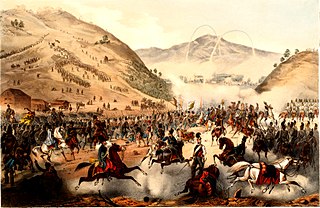 W
WThe Battle of Pákozd was a battle in the Hungarian Revolution of 1848, fought on the 29 September 1848 in the Pákozd – Sukoró – Pátka triangle. It was the first and one of the most important battles of the revolution, in which the Hungarian revolutionary army led by Lieutenant-General János Móga clashed with the troops of the Croatian Ban Josip Jelačić.
 W
WThe Battle of Pered, fought on 20–21 June 1849, was one of the battles which took place in the Summer Campaign of the Hungarian War of Independence from 1848 to 1849, fought between the Hungarian Revolutionary Army and the Habsburg Empire helped by Russian troops. The Hungarian army was led by General Artúr Görgei, while the imperial army by Lieutenant field marshal Julius Jacob von Haynau. After several preliminary minor battles of the Hungarian and Austrian troops along the Vág river, in which the attacking Hungarians could not achieve a success, Görgei took the command of his troops, and after receiving reinforcements, at 20 June, put his troops to attack again towards West. Although the II. Hungarian army corps occupied in heavy fights the village of Pered, the other two corps were unsuccessful, and could not advance. The angered Görgei removed the commander of the III. corps, General Károly Knezić because of his inactivity, and Colonel Lajos Asbóth, the commander of the II. corps who, in contrast to Knezić, was the only commander who successfully accomplished his duties. While Knezić's place was taken by Colonel Károly Leiningen-Westerburg, who was a great choice, Asbóth's place was taken by Colonel József Kászonyi, who was an explicitly bad choice. Haynau, who in the first day of the battle was moving the bulk of his troops to cross the Danube in order to start an attack on its southern bank, sent three of his corps, which were still on the northern bank, to repel the Hungarian forces. The two Austrian and one Russian (Panyutin's) corps started their attack at 21 June, and forced the Hungarians to retreat from Pered and Zsigárd, which forced Görgei to order his troops to retreat from the battlefield.
 W
WThe Battle of Segesvár was a battle in the Hungarian Revolution of 1848, fought on 31 July 1849 between the Hungarian revolutionary army supplemented by Polish volunteers under the command of General Józef Bem and the Russian V Corps under General Alexander von Lüders in ally with the Austrian army led by General Eduard Clam-Gallas. The battle was won by the Russian-Austrian army and it is presumed that the Hungarian poet and national hero Sándor Petőfi died in the battlefield, though his body was never found.
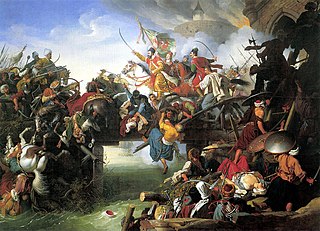 W
WThe siege of Szigetvár or the Battle of Szigeth was a siege of the fortress of Szigetvár, Kingdom of Hungary, that blocked Sultan Suleiman's line of advance towards Vienna in 1566. The battle was fought between the defending forces of the Habsburg Monarchy under the leadership of Nikola IV Zrinski, former Ban of Croatia, and the invading Ottoman army under the nominal command of Sultan Suleiman the Magnificent.
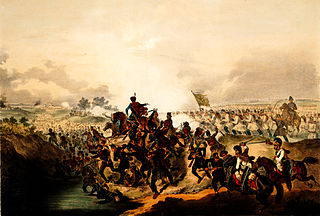 W
WThe Battle of Temesvár was a battle in the Hungarian Revolution of 1848, fought on 9 August 1849 between the Austrian Empire and Hungarian Revolutionary Army supplemented by Polish volunteers and was the last battle of the war. The Austrians were led by Julius Jacob von Haynau, while the Hungarians were led by Józef Bem who arrived at the eleventh hour from Transylvania. The Austrians were victorious.
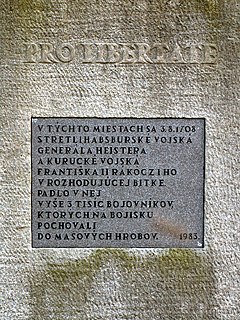 W
WThe Battle of Trenčín or Battle of Trencsén was a battle between the Hungarian Kuruc forces of Francis II Rákóczi and the Imperial Army of the Habsburgs. It was part of Rákóczi's eight-year-long War of Independence.
 W
WThe Black Army, also called the Black Legion/Regiment – possibly after their black armor panoply – is a common name given to the military forces serving under the reign of King Matthias Corvinus of Hungary. The ancestor and core of this early standing mercenary army appeared in the era of his father John Hunyadi in the early 1440s. The idea of the professional standing mercenary army came from Matthias' juvenile readings about the life of Julius Caesar.
 W
WThe F-4 Object is a formerly secret nuclear shelter under the downtown of Budapest. It is located 45-50 metres below the surface, several kilometres long approximately in a "H" shape between Kossuth tér and Szabadság tér. It has a direct connection to the Line 2 of the Budapest Metro and a closed tunnel to the Hungarian Parliament Building. According to other sources, the bunker has a connection with the former headquarters of the Hungarian Working People's Party, and there is no tunnel to the Parliament Building.
 W
WThe Battle of Ilava was a battle in the Hussite Wars between the Hussites and the Hungarian-Royalists army near Ilava in Upper Hungary (Slovakia) on November 9th, 1431.
 W
WThe Imperial Army, German: Kaiserliche Armee), Imperial Troops, or Imperialists (Kaiserliche) for short, was a name used for several centuries, especially to describe soldiers recruited for the Holy Roman Emperor during the Early Modern Period. The Imperial Army of the Emperor should not be confused with the Army of the Holy Roman Empire, which could only be deployed with the consent of the Imperial Diet. The Imperialists effectively became a standing army of troops under the Habsburg emperor from the House of Austria, which is why they were also increasingly described in the 18th century as "Austrians", although its troops were recruited not just from the Archduchy of Austria but from all over the Holy Roman Empire.
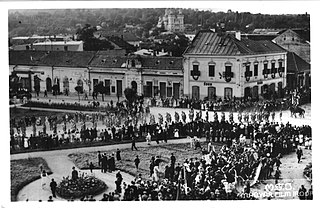 W
WThe events of the Ip massacre escalated in the early hours of 14 September 1940, in Ipp,, Northern Transylvania. After two Hungarian soldiers died there in an accidental explosion, rumors spread that they had been killed by Romanians. After another incident the Royal Hungarian Army, influenced by the rumor, indiscriminately massacred around 150 ethnic Romanians in the nearby locations and surrounding areas.
 W
WThe Battle of Keresztes took place on 24–26 October 1596. It was fought between a combined Habsburg-Transylvanian force and the Ottoman Empire near the village of Mezőkeresztes in northern Hungary. The Ottomans routed the Habsburg-led army but Ottoman casualties were too high for them to pursue.
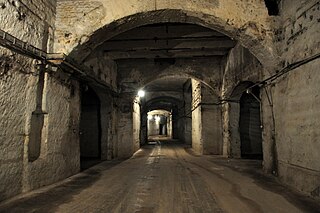 W
WThe Kőbánya cellar system or cellar system of Kőbánya, sometimes known to non-Hungarians simply as the Kőbánya Mine, or the Kobanya Mine, is an extensive network of subterranea, or underground spaces, in the 10th district of Budapest (Kőbánya), in Hungary. It is considered to be the largest cellar complex in the country. The complex as a whole started as an underground limestone quarry in a wine-growing area of present-day Kőbánya in the Middle Ages. Later wineries and beer breweries were established on the premises and they continued to use some of the underground spaces. During the Second World War, the dimensions of the complex enabled it to be used as a covert aircraft engine assembly plant and a civilian hideout. Since 2008, Kőbánya Asset Manager Jsc. organizes free guided tours annually, which introduce visitors to both the complex and the Havas Villa, one of the most notable properties connected to it. The underground complex is one of the locations that are participating in the European Heritage Days.
 W
WThe Battle of Köbölkút was fought on August 5, 1663 as part of the Austro-Turkish War (1663–1664), between a Habsburg army and an Ottoman army under the command of Grand Vizier Köprülü Fazıl Ahmed. The battle took place near Köbölkút, Kingdom of Hungary and was an absolute Ottoman victory.
 W
WKuruc, also spelled kurutz, refers to a group of armed anti-Habsburg insurgents in the Kingdom of Hungary between 1671 and 1711.
 W
WThis page is partially a translation of the French version
 W
WLevente Associations or simply levente were paramilitary youth organizations in Hungary during the interwar period and the Second World War. They were established in 1921 with the declared purpose of physical and health training. As of the mid-1930s, they became a de facto method of circumventing the ban on conscription imposed on Hungary by the Treaty of Trianon and over time, openly became a paramilitary organization under the leadership of military veterans. As of 1939, under the Act of Defense, all boys aged 12–21 were required to join the levente.
 W
WThe Royal Hungarian Ludovica Defense Academy, shortened to Ludovica or Ludovica Academy, was Hungary's officer cadets training institute prior to 1945. The main edifice of the Academy was erected in 1836 at the Ludovica Garden, in Budapest's centrally located VIIIth district. The building was designed by Mihály Pollack in the classical style.
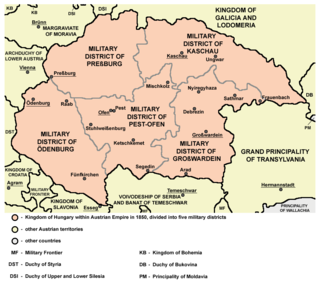 W
WThe Military District of Großwardein was one of the administrative units of the Habsburg Kingdom of Hungary from 1850 to 1860. The seat of the district was Großwardein. It included parts of present-day Romania, Hungary, and Ukraine.
 W
WThe Military District of Kaschau was one of the administrative units of the Habsburg Kingdom of Hungary from 1850 to 1860. The seat of the district was Kaschau. It included territories of present-day Slovakia, Hungary and Ukraine.
 W
WThe Military District of Ödenburg was one of the administrative units of the Habsburg Kingdom of Hungary from 1850 to 1860. The seat of the district was Ödenburg (Sopron). It included parts of present-day Hungary, Austria, Croatia, and Slovenia.
 W
WThe Military District of Pest-Ofen was one of the administrative units of the Habsburg Kingdom of Hungary from 1850 to 1860. The seat of the district was Ofen (Buda). It included central parts of present-day Hungary.
 W
WThe Military District of Preßburg was one of the administrative units of the Habsburg Kingdom of Hungary from 1850 to 1860. The seat of the district was Preßburg. It included western parts of present-day Slovakia and northern parts of present-day Hungary.
 W
WThe Imperial and Royal Minister of War, until 1911: Reich Minister of War (Reichskriegsminister), was the head of one of the three common ministries shared by the two states which made up the dual monarchy of Austria-Hungary from its creation in the Compromise of 1867 until its dissolution in 1918.
 W
WThe Nușfalău massacre occurred in the village of Szilágynagyfalu in Northern Transylvania. It happened on 8 September 1940, when a Hungarian soldier with the support of some natives tortured and killed eleven people of Romanian ethnicity from a nearby village, who were passing through the area.
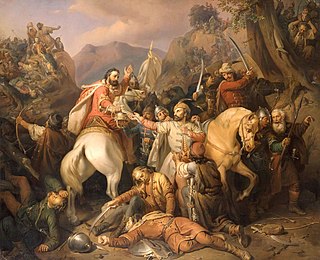 W
WThe Battle of Posada was fought between Basarab I of Wallachia and Charles I of Hungary.
 W
WPál Prónay de Tótpróna et Blatnicza was a Hungarian reactionary and paramilitary commander in the years following the First World War. He is considered to have been the most brutal of the Hungarian National Army officers who led the White Terror that followed Hungary's brief 1919 Communist coup d'état.
 W
WThe "Rongyos Gárda" were a non-regular paramilitary unit in Hungary, active in 1921 then reestablished in 1938.
 W
WThe Royal Hungarian Army was the name given to the land forces of the Kingdom of Hungary in the period from 1922 to 1945. Its name was inherited from the Royal Hungarian Honvéd which went under the same Hungarian title of Magyar Királyi Honvédség from 1867 to 1918. Initially restricted by the Treaty of Trianon to 35,000 men, the army was steadily upgraded during the 1930s and fought on the side of the Axis powers in the Second World War.
 W
WThe Royal Hungarian Honvéd, Royal Hungarian Honved or Royal Hungarian Landwehr, commonly known as the Honved, Honvéd or in Hungarian, Honvédség, was one of the four armed forces of Austria-Hungary from 1867 to 1918. The others were its counterpart the Austrian Landwehr, the Common Army and the Imperial and Royal Navy. The word "honvéd" means an enlisted private without a rank, literally "Defender of the Homeland". "Honvédség" is degree of the noun and refers to the community, institution of these soldiers.
 W
WThe Battle of Saint Gotthard, of the Austro-Turkish War (1663–1664), took place on 1 August 1664 on the Raab between Mogersdorf and the Cistercian monastery St. Gotthard in German West Hungary. It was fought between Imperial Army forces, including Germans, Swedish and French contingents, led by Imperial Commander in Chief Count Raimondo Montecuccoli and the army of the Ottoman Empire under the command of Köprülü Fazıl Ahmed Paşa.
 W
WThe siege of Buda ended with the capture of the city of Buda, Hungary by the Ottoman Empire, leading to 150 years of Ottoman control of Hungary. The siege, part of the Little War in Hungary, was one of the most important Ottoman victories over the Habsburg Monarchy during Ottoman–Habsburg wars in Hungary and the Balkans.
 W
WThe siege of Vienna was a decisive siege in 1485 of the Austrian–Hungarian War. It was a consequence of the ongoing conflict between Frederick III and Matthias Corvinus. The fall of Vienna meant that it merged with Hungary from 1485 to 1490. Matthias Corvinus also moved his royal court to the newly occupied city. Vienna became for more than a decade the capital of Hungary.
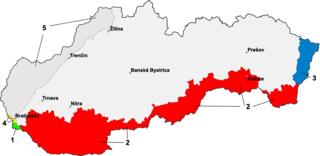 W
WThe Slovak–Hungarian War, or Little War, was a war fought from 23 March to 31 March 1939 between the First Slovak Republic and Hungary in eastern Slovakia.
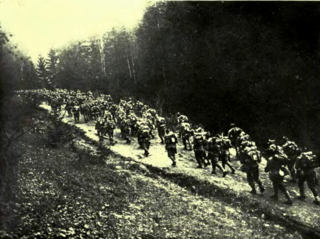 W
WThe Battle of Transylvania was the first major operation of the Romanian forces Campaign during World War I, beginning on 27 August 1916. It started as an attempt by the Romanian Army to seize Transylvania, and potentially knock Austria-Hungary out of the war. Although initially successful, the offensive was brought to a halt after Bulgaria's attack on Dobruja. Coupled with a successful German and Austro-Hungarian counterattack which started in mid-September, the Romanian Army was eventually forced to retreat back to the Carpathians by mid-October. The Romanian armies however managed to escape the Central Powers' attempts to completely destroy them. The Battle of Transylvania also caused the replacement of the Chief of Staff of the German Army and the shifting of German attention to the region, causing German offensive operations at Verdun to cease.
 W
WThe Battle of Trnava or Battle of Nagyszombat was a battle in the Hussite Wars between the Hussites and the Hungarian-Royalists-Serbian army near Trnava (Nagyszombat) in the Kingdom of Hungary. The battle was fought in three phases, on 23, 25 and 28 April 1430 and ended in Hussite victory.